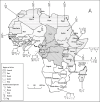Methods and Tools Used for Biosecurity Assessment in Livestock Farms in Africa: A Scoping Review
- PMID: 40303185
- PMCID: PMC12016981
- DOI: 10.1155/2024/5524022
Methods and Tools Used for Biosecurity Assessment in Livestock Farms in Africa: A Scoping Review
Abstract
Farm biosecurity has gained increasing attention worldwide during the last decades because of its role in reducing the occurrence of diseases and improving animal performance. Recently, recommendations to reinforce the concept of farm biosecurity in lower- and middle-income countries have been advised. Therefore, this review aims to provide a comprehensive description of the methods and tools used to assess biosecurity compliance in livestock farms in Africa and formulate recommendations. The present review followed the Preferred Reporting Items for Systematic Reviews and Meta-Analysis extension for scoping reviews guidelines. Peer-reviewed studies reporting biosecurity assessment in poultry, cattle, pig, goat, or sheep farms in Africa were included. Five databases were searched with no date restrictions. A total of 41 studies across 17 countries were finally selected. Selected studies were all published after 2008, and an increasing trend in the number of papers published per year was noticed. In total, 41 different methods for biosecurity assessment were found to be used in African countries, meaning that even within the same country, the same animal species, and the same farming system, different methods were utilized. In many papers, the methods used for biosecurity evaluation were poorly described. In addition, during the biosecurity assessment, measures related to the purchase of laying hens, egg transport and management, calves, calving and dairy management, and nursery units were almost not considered. These measures should be contemplated in future studies since they are related to important risk factors for the introduction and dissemination of infectious diseases. Interestingly, some measures not considered in European biosecurity tools were identified in the selected studies. The observed high difference in methods used may be due to the lack of regulations on biosecurity in African countries; therefore, the authors recommend the development and implementation of a harmonized and contextualized method for the assessment of biosecurity in livestock farms in Africa.
Copyright © 2024 Ronald Vougat Ngom et al.
Conflict of interest statement
The authors declare that there are no conflicts of interest.
Figures





References
-
- Mngumi F., Sun N., Shair F., Huang L., Shaorong S. Livestock sector correlation with other economic activities: the impact of productivity using green finance to increase National gross domestic product. Journal of Livestock Science (ISSN online 2277-6214) . 2023;14:1–13.
-
- Gezahegn A., Girma Z., Berhanu A. Seroprevalence of foot and mouth disease (FMD) and associated economic impact on Central Ethiopian cattle feedlots. Journal of Veterinary Medicine and Animal Health . 2014;6(5):154–158.
Publication types
MeSH terms
LinkOut - more resources
Full Text Sources

